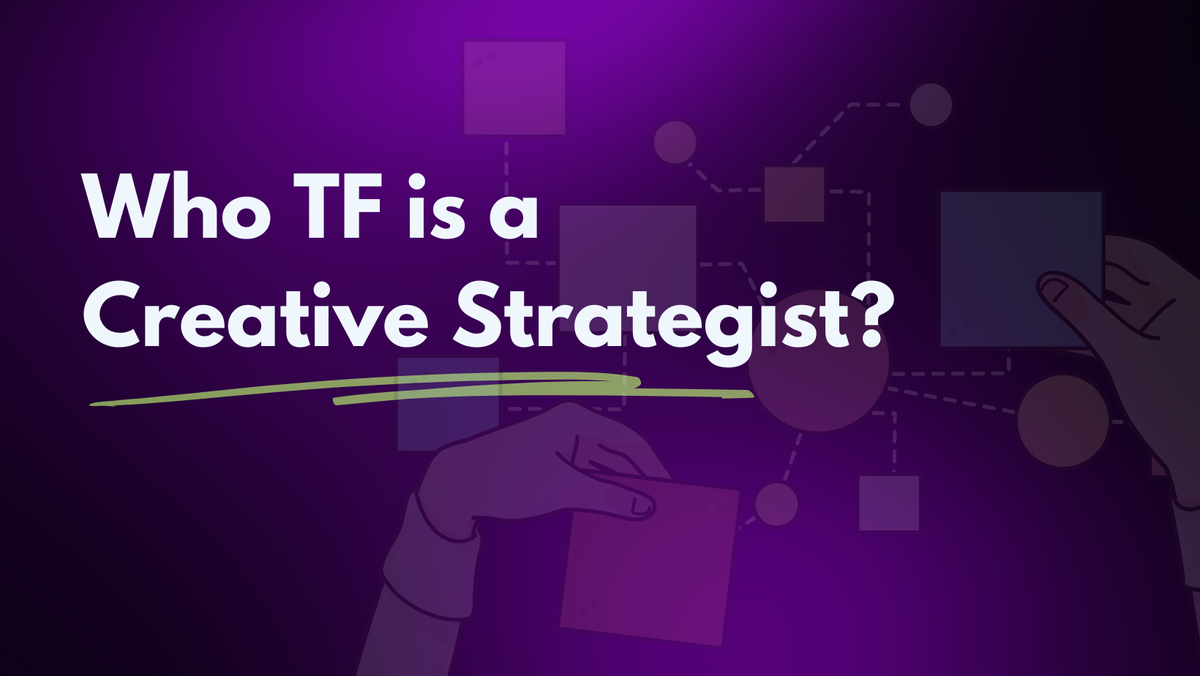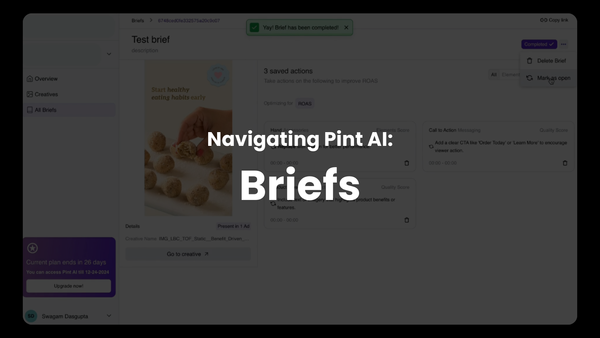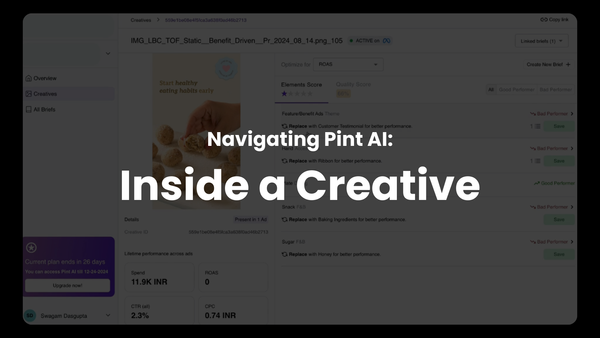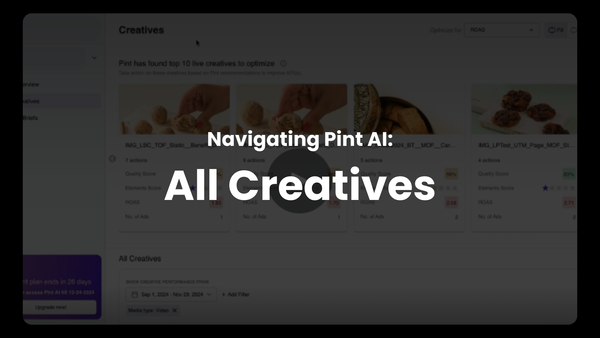Creative Analytics 108: Who TF is a Creative Strategist?
The demand for creative strategists is rising, especially among agencies and D2C brands. Here's why

The role of a creative strategist is emerging as a crucial element for the success of marketing campaigns. A creative strategist bridges the gap between innovative creative ideas and strategic business objectives, ensuring that marketing efforts are not only imaginative but also aligned with broader business goals.
The need for this kind of role, especially in agencies and D2C brands, is becoming more and more pronounced. But what exactly does a creative strategist do?
The Role of Creative Strategists
Creative strategists are the linchpins in the marketing machinery. Their primary responsibility is to craft strategies that effectively marry creativity with strategic objectives. This involves a deep understanding of both the creative and analytical aspects of marketing.
Market Research and Trend Monitoring
- Staying abreast of the latest market trends and understanding consumer behavior is fundamental to a creative strategist’s role. They utilize various tools and methodologies to gather insights about market dynamics, consumer preferences, and competitive landscapes.
- For example, platforms like Google Analytics and social listening tools such as Hootsuite Insights enable creative strategists to monitor and analyze trends, providing valuable data that informs their strategies.
Developing and Testing Marketing Strategies
- Creative strategists are responsible for developing innovative marketing strategies and rigorously testing them to ensure they achieve the desired impact. This process often involves A/B testing, focus groups, and other methods to gauge the effectiveness of different creative approaches.
- They work closely with various stakeholders, including creative teams and leadership, to ensure that the strategies align with the brand’s goals and resonate with the target audience.
Project and Client Management
- Managing multiple projects and campaigns simultaneously is a significant part of a creative strategist’s job. This requires strong organizational and project management skills to keep everything on track.
- Effective communication with clients and team members is also crucial. Creative strategists must be adept at articulating their ideas and strategies, ensuring that everyone involved understands the campaign's objectives and their role in achieving them.
Writing Campaign Briefs
- Crafting detailed and clear campaign briefs is essential for guiding the creative team. These briefs provide the necessary context and direction for copywriters, designers, and other creatives, ensuring that their work aligns with the overall strategy.
Tracking Campaign Progress
- Once a campaign is launched, creative strategists closely monitor its performance. They analyze various metrics to assess what’s working and what’s not, making adjustments as needed to optimize the campaign's effectiveness.
Skills Required for Creative Strategists
To succeed as a creative strategist, one needs a diverse skill set that spans both creative and analytical domains. Here are some key skills:
Analytical Thinking
Creative strategists must be able to analyze data and extract meaningful insights that can inform their strategies. This involves using various analytical tools and techniques to understand market trends and consumer behavior.
Creative Problem Solving
Creativity is at the heart of this role. Creative strategists need to think outside the box to develop innovative solutions that capture the audience’s attention and drive engagement.
Communication Skills
Both written and verbal communication skills are critical. Writing clear and concise campaign briefs, as well as effectively communicating ideas and strategies to clients and team members, is essential.
Project Management
Managing multiple projects and ensuring they are completed on time and within budget requires strong project management skills. Creative strategists need to be organized and detail-oriented.
Knowledge of Digital Marketing
A deep understanding of digital marketing platforms and tools is necessary. Creative strategists must stay updated with the latest developments in digital marketing, including changes in algorithms and new advertising options.
Here's creative strategy expert Dara Denney's free tutorial
Tools Used by Creative Strategists
A creative strategist's role involves leveraging various tools to gather insights, develop strategies, and execute campaigns. Here are some essential tools:
Market Research and Consumer Insight Tools
Tools like SurveyMonkey and Google Forms are useful for conducting surveys and gathering consumer feedback. Web analytics platforms such as Google Analytics provide valuable insights into user behavior. You can also look at tools like Google Trends or SEO research tools like Ubersuggest to figure out consumer trends.
Planning and Audience Tools
Collaborative platforms like Miro, Trello, and Notion help in brainstorming and strategic planning. CRM platforms like HubSpot and Salesforce are used for audience segmentation and targeting.
Creative Development Tools
Creative suites like Adobe Creative Suite and Canva are indispensable for creating compelling visuals. Video editing tools such as Adobe Premiere Pro are essential for producing high-quality video content.
Digital Asset Management (DAM) Platforms
DAM platforms like Focal help in organizing, managing, and distributing digital assets efficiently. These tools also enable creative strategists to iterate quickly on creative concepts based on performance data.
Project Management and Collaboration Tools
Tools like Asana and Monday.com help keep projects on track, while communication platforms like Slack facilitate seamless collaboration among team members.
Data Analysis and Reporting Tools
Advanced data visualization tools like Tableau and Looker Studio are used to analyze campaign performance and derive actionable insights. Tools like Pint AI also allow you to analyze performance at the creative level.
Job Market Demand for Creative Strategists
The demand for creative strategists is robust and growing, driven by the increasing importance of digital marketing and the need for innovative marketing solutions.
Growing Importance of Ad Creative
As online ad spend continues to rise and targeting becomes more restrictive, the importance of creative strategies has increased. Creative strategists play a crucial role in ensuring that ad creatives are impactful and drive campaign performance.
High Demand for Marketing and Creative Roles
According to Robert Half’s Demand for Skilled Talent report, marketing and creative roles are among the top in-demand positions for 2024. This includes permanent and contract roles, with a significant portion of new jobs in the professional and business services sector.
Competitive Salaries and Flexible Work Arrangements
Creative strategists are well-compensated, with median annual salaries around $95,000. Companies are also offering flexible work arrangements, including remote and hybrid options, to attract and retain top talent.
Evolving Job Market Trends
The job market for creative strategists is evolving, with new roles emerging and existing roles expanding. Positions such as influencer marketing specialists, growth marketing managers, and UX/UI designers are also in high demand, reflecting the diverse opportunities available for creative professionals.
Conclusion
The role of a creative strategist is both challenging and rewarding, requiring a unique blend of creativity and strategic thinking. As the digital marketing landscape continues to evolve, the demand for skilled creative strategists is set to increase, offering exciting opportunities for those with the right skills and mindset. Whether you are just starting your career or looking to pivot into a new role, understanding the responsibilities, skills, and tools required for a creative strategist can help you navigate this dynamic field and achieve success.
By staying updated with market trends, leveraging the right tools, and continuously honing their skills, creative strategists can play a pivotal role in driving the success of marketing campaigns and contributing to the overall growth of their organizations.





